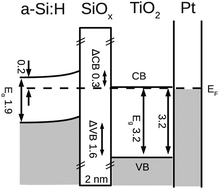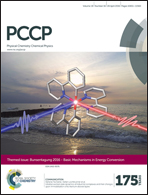Band engineering for efficient catalyst-substrate coupling for photoelectrochemical water splitting†
Abstract
To achieve an overall efficient solar water splitting device, not only the efficiencies of photo-converter and catalyst are decisive, but also their appropriate coupling must be considered. In this report we explore the origin of a voltage loss occurring at the interface between a thin film amorphous silicon tandem cell and the TiO2 corrosion protection layer by means of XPS. We find that the overall device can be disassembled into its primary constituents and that they can be analyzed separately, giving insight into the device structure as a whole. Thus, a series of model experiments were conducted, each representing a part of the complete device. We finally arrive at the conclusion, that the formation of a SiO2 interfacial layer between the TiO2 protection layer and the silicon cell gives rise to the voltage loss observed for the whole device.

- This article is part of the themed collection: Bunsentagung 2016: Basic Mechanisms in Energy Conversion


 Please wait while we load your content...
Please wait while we load your content...